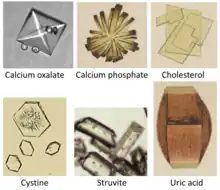| |||
| Identifiers | |||
|---|---|---|---|
3D model (JSmol) |
|||
| ChEBI | |||
| ChEMBL | |||
| ChemSpider | |||
| ECHA InfoCard | 100.000.270 | ||
| KEGG | |||
PubChem CID |
|||
| UNII | |||
CompTox Dashboard (EPA) |
|||
| |||
| |||
| Properties | |||
| C6H12N2O4S2 | |||
| Molar mass | 240.29 g·mol−1 | ||
| Hazards | |||
| Safety data sheet (SDS) | External MSDS | ||
Except where otherwise noted, data are given for materials in their standard state (at 25 °C [77 °F], 100 kPa).
Infobox references | |||
Cystine is the oxidized derivative of the amino acid cysteine and has the formula (SCH2CH(NH2)CO2H)2. It is a white solid that is poorly soluble in water. As a residue in proteins, cystine serves two functions: a site of redox reactions and a mechanical linkage that allows proteins to retain their three-dimensional structure.[1]
Formation and reactions
Structure
Cystine is the disulfide derived from the amino acid cysteine. The conversion can be viewed as an oxidation:
- 2 HO2CCH(NH2)CH2SH + 0.5 O2 → (HO2CCH(NH2)CH2S)2 + H2O
Cystine contains a disulfide bond, two amine groups, and two carboxylic acid groups. As for other amino acids, the amine and carboxylic acid groups exist in rapid equilibrium with the ammonium-carboxylate tautomer. The great majority of the literature concerns the l,l-cystine, derived from l-cysteine. Other isomers include d,d-cystine and the meso isomer d,l-cystine, neither of which is biologically significant.
Occurrence
Cystine is common in many foods such as eggs, meat, dairy products, and whole grains as well as skin, horns and hair. It was not recognized as being derived of proteins until it was isolated from the horn of a cow in 1899.[2] Human hair and skin contain approximately 10–14% cystine by mass.[3]
History
Cystine was discovered in 1810 by the English chemist William Hyde Wollaston, who called it "cystic oxide".[4] In 1833, the Swedish chemist Jöns Jacob Berzelius named the amino acid "cystine".[5] The Norwegian chemist Christian J. Thaulow determined, in 1838, the empirical formula of cystine.[6] In 1884, the German chemist Eugen Baumann found that when cystine was treated with a reducing agent, cystine revealed itself to be a dimer of a monomer which he named "cysteïne".[7] In 1899, cystine was first isolated from protein (horn tissue) by the Swedish chemist Karl A. H. Mörner (1855-1917).[8] The chemical structure of cystine was determined by synthesis in 1903 by the German chemist Emil Erlenmeyer.[9][10][11]
Redox
It is formed from the oxidation of two cysteine molecules, which results in the formation of a disulfide bond. In cell biology, cystine residues (found in proteins) only exist in non-reductive (oxidative) organelles, such as the secretory pathway (endoplasmic reticulum, Golgi apparatus, lysosomes, and vesicles) and extracellular spaces (e.g., extracellular matrix). Under reductive conditions (in the cytoplasm, nucleus, etc.) cysteine is predominant. The disulfide link is readily reduced to give the corresponding thiol cysteine. Typical thiols for this reaction are mercaptoethanol and dithiothreitol:
- (SCH2CH(NH2)CO2H)2 + 2 RSH → 2 HSCH2CH(NH2)CO2H + RSSR
Because of the facility of the thiol-disulfide exchange, the nutritional benefits and sources of cystine are identical to those for the more-common cysteine. Disulfide bonds cleave more rapidly at higher temperatures.[12]
Cystine-based disorders

The presence of cystine in urine is often indicative of amino acid reabsorption defects. Cystinuria has been reported to occur in dogs.[13] In humans the excretion of high levels of cystine crystals can be indicative of cystinosis, a rare genetic disease. Cystine stones account for about 1-2% of kidney stone disease in adults.[14][15]
Biological transport
Cystine serves as a substrate for the cystine-glutamate antiporter. This transport system, which is highly specific for cystine and glutamate, increases the concentration of cystine inside the cell. In this system, the anionic form of cystine is transported in exchange for glutamate. Cystine is quickly reduced to cysteine. Cysteine prodrugs, e.g. acetylcysteine, induce release of glutamate into the extracellular space.
Nutritional supplements
Cysteine supplements are sometimes marketed as anti-aging products with claims of improved skin elasticity. Cysteine is more easily absorbed by the body than cystine, so most supplements contain cysteine rather than cystine. N-acetyl-cysteine (NAC) is better absorbed than other cysteine or cystine supplements.
See also
- Lanthionine, similar with mono-sulfide link
- Protein tertiary structure
- Sullivan reaction
- Cystinosis
References
- ↑ Nelson, D. L.; Cox, M. M. (2000) Lehninger, Principles of Biochemistry. 3rd Ed. Worth Publishing: New York. ISBN 1-57259-153-6.
- ↑ "cystine". Encyclopædia Britannica. 2007. Encyclopædia Britannica Online. 27 July 2007
- ↑ Gortner, R. A.; Hoffman, W. F. (1925). "l-Cystine". Organic Syntheses. 5: 39.
- ↑ Wollaston, William Hyde (1810). "On cystic oxide, a new species of urinary calculus". Philosophical Transactions of the Royal Society of London. 100: 223–230. On p. 227, Wollaston named cystine "cystic oxide".
- ↑ Berzelius, J.J.; Esslinger, Me., trans. (1833). Traité de Chimie (in French). Vol. 7. Paris, France: Didot Frères. p. 424.
{{cite book}}: CS1 maint: multiple names: authors list (link) From p. 424: "10. Cystine. Cette substance a été découverte dans les calculs urinaires par Wollaston, […] je me suis donc permis de changer le nom qu'avait proposé cet homme distingué." (10. Cystine. This substance was discovered in urinary calculi by Wollaston, who gave it the name of "cystic oxide" because it dissolves as much in acids as in alkalis, and it resembles, in this respect, some metallic oxides; but, in a way, the reason [that was] alleged to justify it is not valid: I have therefore taken the liberty of changing the name that this distinguished man had proposed.) - ↑ Thaulow, C. J. (1838). "Sur la composition de la cystine" [On the composition of cystine]. Journal de Pharmacie (in French). 24: 629–632.
- ↑ Baumann, E. (1884). "Ueber Cystin und Cysteïn" [On cystine and cysteine]. Zeitschrift für physiologische Chemie (in German). 8: 299–305. From pp. 301-302: "Die Analyse der Substanz ergibt Werthe, welche den vom Cystin (C6H12N2S2O4) verlangten sich nähern, […] nenne ich dieses Reduktionsprodukt des Cystins: Cysteïn." (Analysis of the substance [cysteine] reveals values which approximate those [that are] required by cystine (C6H12N2S2O4), however the new base [cysteine] can clearly be recognized as a reduction product of cystine, to which the [empirical] formula C3H7NSO2, [which had] previously [been] ascribed to cystine, is [now] ascribed. In order to indicate the relationships of this substance to cystine, I name this reduction product of cystine: "cysteïne".) Note: Baumann's proposed structures for cysteine and cystine (see p.302) are incorrect: for cysteine, he proposed CH3CNH2(SH)COOH .
- ↑ Mörner, K. A. H. (1899). "Cystin, ein Spaltungsprodukt der Hornsubstanz" [Cystine, a cleavage product of horn tissue]. Hoppe-Seyler's Zeitschrift für Physiologische Chemie (in German). 28 (5–6): 595–615. doi:10.1515/bchm2.1899.28.5-6.595.
- ↑ Erlenmeyer, Emil (1903). "Synthese des Cystins" [Synthesis of cystine]. Berichte der Deutschen Chemischen Gesellschaft (in German). 36 (3): 2720–2722. doi:10.1002/cber.19030360320.
- ↑ Erlenmeyer, E. jun.; Stoop, F. (1904). "Ueber die Synthese einiger α-Amido-β-hydroxysäuren. 2. Ueber die Synthese der Serins und Cystins" [On the synthesis of some α-amido-β-hydroxy acids. 2. On the synthesis of serine and cystine.]. Annalen der Chemie (in German). 337: 236–263. doi:10.1002/jlac.19043370205. Discussion of the synthesis of cystine begins on p. 241.
- ↑ Erlenmeyer's findings regarding the structure of cystine were confirmed in 1908 by Fischer and Raske. See: Fischer, Emil; Raske, Karl (1908). "Verwandlung des l-Serines in aktives natürliches Cystin" [Conversion of l-serine into [optically] active natural cystine]. Berichte der Deutschen Chemischen Gesellschaft (in German). 41: 893–897. doi:10.1002/cber.190804101169.
- ↑ Aslaksena, M.A.; Romarheima, O.H.; Storebakkena, T.; Skrede, A. (28 June 2006). "Evaluation of content and digestibility of disulfide bonds and free thiols in unextruded and extruded diets containing fish meal and soybean protein sources". Animal Feed Science and Technology. 128 (3–4): 320–330. doi:10.1016/j.anifeedsci.2005.11.008.
- ↑ Gahl, William A.; Thoene, Jess G.; Schneider, Jerry A. (2002). "Cystinosis". New England Journal of Medicine. 347 (2): 111–121. doi:10.1056/NEJMra020552. PMID 12110740.
- ↑ Frassetto L, Kohlstadt I (2011). "Treatment and prevention of kidney stones: an update". Am Fam Physician. 84 (11): 1234–42. PMID 22150656.
- ↑ "Cystine stones". UpToDate. Archived from the original on 26 February 2014. Retrieved 20 February 2014.
External links
 Media related to Cystine at Wikimedia Commons
Media related to Cystine at Wikimedia Commons

